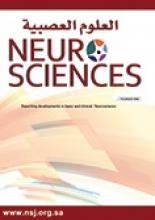Research ArticleOriginal Article
Open Access
Planimetry investigation of the corpus callosum in temporal lobe epilepsy patients
Veli Caglar, Selen I. Alp, Berrin T. Demir, Umit Sener, Oguz A. Ozen and Recep Alp
Neurosciences Journal April 2016, 21 (2) 145-150; DOI: https://doi.org/10.17712/nsj.2016.2.20150783
Veli Caglar
From the Departments of Anatomy (Caglar, Ozen), Physiology (Sener), and Neurology (Alp R), Faculty of Medicine, and the Vocational School of Health Service (Alp S), Namik Kemal University, Tekirdag, and the Department of Anatomy (Demir), Faculty of Medicine, Turgut Ozal University, Ankara, Turkey
PhDSelen I. Alp
From the Departments of Anatomy (Caglar, Ozen), Physiology (Sener), and Neurology (Alp R), Faculty of Medicine, and the Vocational School of Health Service (Alp S), Namik Kemal University, Tekirdag, and the Department of Anatomy (Demir), Faculty of Medicine, Turgut Ozal University, Ankara, Turkey
MDBerrin T. Demir
From the Departments of Anatomy (Caglar, Ozen), Physiology (Sener), and Neurology (Alp R), Faculty of Medicine, and the Vocational School of Health Service (Alp S), Namik Kemal University, Tekirdag, and the Department of Anatomy (Demir), Faculty of Medicine, Turgut Ozal University, Ankara, Turkey
PhDUmit Sener
From the Departments of Anatomy (Caglar, Ozen), Physiology (Sener), and Neurology (Alp R), Faculty of Medicine, and the Vocational School of Health Service (Alp S), Namik Kemal University, Tekirdag, and the Department of Anatomy (Demir), Faculty of Medicine, Turgut Ozal University, Ankara, Turkey
MDOguz A. Ozen
From the Departments of Anatomy (Caglar, Ozen), Physiology (Sener), and Neurology (Alp R), Faculty of Medicine, and the Vocational School of Health Service (Alp S), Namik Kemal University, Tekirdag, and the Department of Anatomy (Demir), Faculty of Medicine, Turgut Ozal University, Ankara, Turkey
MDRecep Alp
From the Departments of Anatomy (Caglar, Ozen), Physiology (Sener), and Neurology (Alp R), Faculty of Medicine, and the Vocational School of Health Service (Alp S), Namik Kemal University, Tekirdag, and the Department of Anatomy (Demir), Faculty of Medicine, Turgut Ozal University, Ankara, Turkey
MD
References
- ↵
- Treitz FH,
- Daum I,
- Faustmann PM,
- Haase CG
- ↵
- Chiang S,
- Haneef Z
- ↵
- Kurkcuoglu A,
- Zagyapan R,
- Pelin C
- ↵
- Firat A,
- Tascioglu AB,
- Demiryurek MD,
- Saygi S,
- Karli Oguz K,
- Tezer FI,
- et al.
- ↵
- Giedd JN,
- Rumsey JM,
- Castellanos FX,
- Rajapakse JC,
- Kaysen D,
- Vaituzis AC,
- et al.
- ↵
- Bernasconi N,
- Bernasconi A,
- Caramanos Z,
- Antel SB,
- Andermann F,
- Arnold DL
- ↵
- Sahin B,
- Ergur H
- ↵
- Barboriak DP,
- Padua AO,
- York GE,
- Macfall JR
- ↵
- Acer N,
- Sahin B,
- Ucar T,
- Usanmaz M
- ↵
- Acer N,
- Sahin B,
- Baş O,
- Ertekin T,
- Usanmaz M
- ↵
- Acer N,
- Sahin B,
- Usanmaz M,
- Tatoğlu H,
- Irmak Z
- ↵
- Ronan L,
- Murphy K,
- Delanty N,
- Doherty C,
- Maguire S,
- Scanlon C,
- et al.
- ↵
- Scanlon C,
- Mueller SG,
- Cheong I,
- Hartig M,
- Weiner MW,
- Laxer KD
- ↵
- Dabbs K,
- Becker T,
- Jones J,
- Rutecki P,
- Seidenberg M,
- Hermann B
- ↵
- O’Dwyer R,
- Wehner T,
- LaPresto E,
- Ping L,
- Tkach J,
- Noachtar S,
- et al.
- ↵
- Pulsipher DT,
- Seidenberg M,
- Morton JJ,
- Geary E,
- Parrish J,
- Hermann B
- ↵
- O’Kusky J,
- Strauss E,
- Kosaka B,
- Wada J,
- Li D,
- Druhan M,
- et al.
- ↵
- Harris RM,
- Sundsten JW,
- Fischer-Wright RA
- ↵
- Ozdemir ST,
- Ercan I,
- Sevinc O,
- Guney I,
- Ocakoglu G,
- Aslan E,
- et al.
- ↵
- Witelson SF
- ↵
- Tang Y,
- Nyengaard JR,
- Pakkenberg B,
- Gundersen HJ
- ↵
- Hermann B,
- Hansen R,
- Seidenberg M,
- Magnotta V,
- O’Leary D
- ↵
- Hermann B,
- Seidenberg M,
- Bell B,
- Rutecki P,
- Sheth R,
- Ruggles K,
- et al.
- ↵
- Hutchinson E,
- Pulsipher D,
- Dabbs K,
- Myersy Gutierrez A,
- Sheth R,
- Jones J,
- et al.
In this issue
Planimetry investigation of the corpus callosum in temporal lobe epilepsy patients
Veli Caglar, Selen I. Alp, Berrin T. Demir, Umit Sener, Oguz A. Ozen, Recep Alp
Neurosciences Journal Apr 2016, 21 (2) 145-150; DOI: 10.17712/nsj.2016.2.20150783
Jump to section
Related Articles
- No related articles found.
Cited By...
- No citing articles found.





